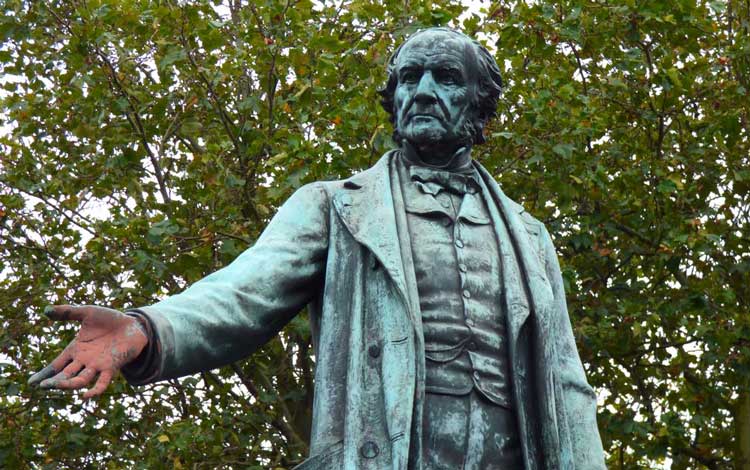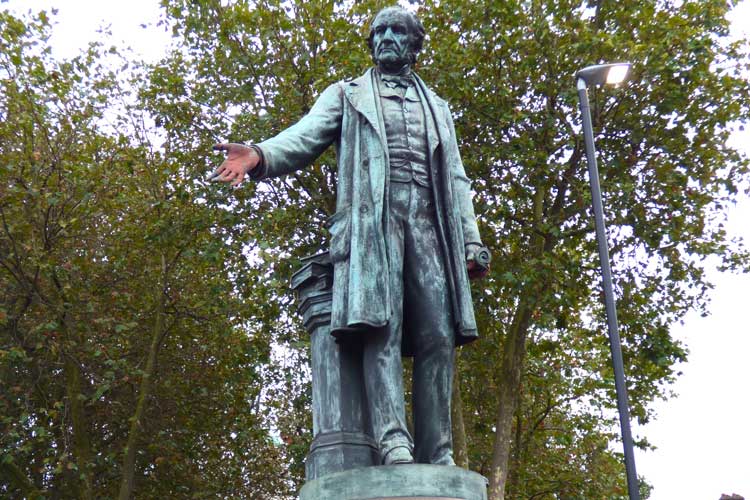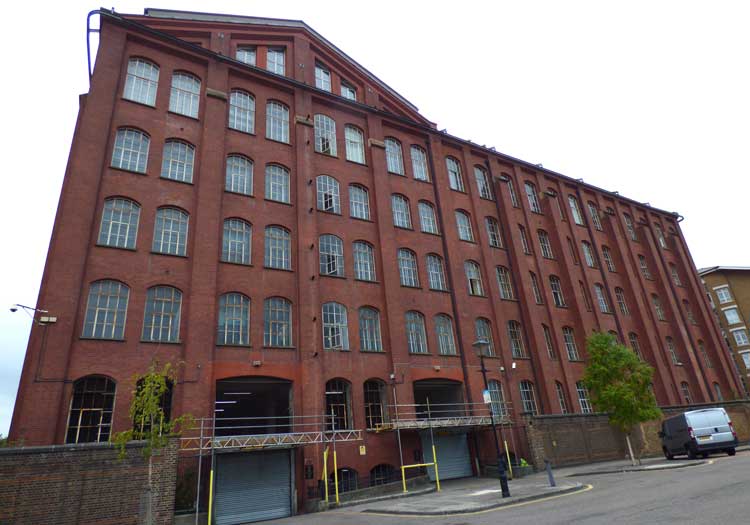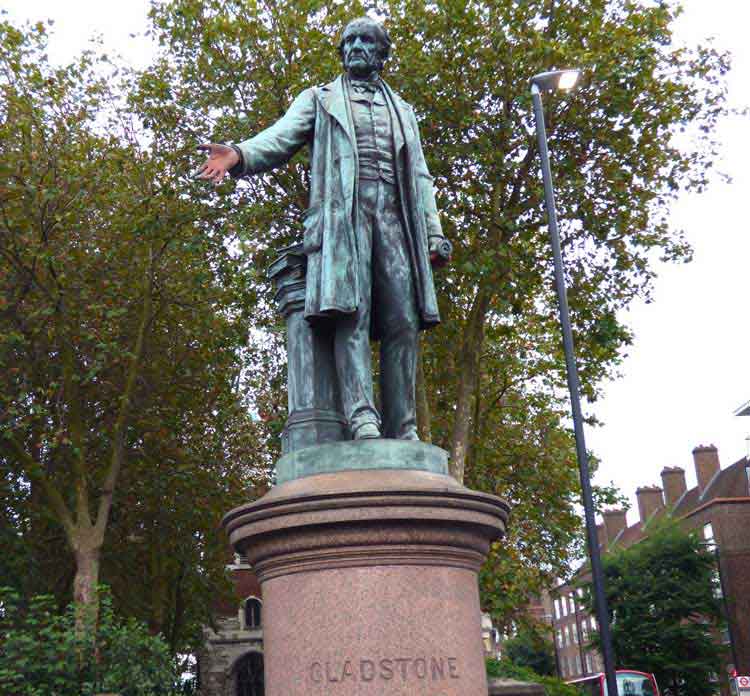
Spending an hour or so beneath the looming shadow of the Bow flyover might not seem like the most productive use of your time. But, if you do so, you will find a curious looking statue with an even curiouser story behind it.
And it all has to do with your humble everyday match.
The statue in question is of William Ewart Gladstone (1809 - 1898), and he stands on the west side of one of east London's most historic churches, the parish church of St Mary and Holy Trinity, or, as it is better known to those who might only be familiar with this little section of London as the destination on the front of the Number 8 bus, which terminates here - Bow Church.
The church is notable for many things. It has, after all, been in existence for more than seven hundred years and, in consequence, it has a long and distinguished history.
However, the one thing that has always stuck in my mind about this delightful little church is that the Reverend Samuel Henshaw, the man who, in 1795, took out the first patent on a design for a corkscrew, was once its Rector. And, although that little nugget of information probably doesn't tell you a great deal about the church's history, it certainly tells you something about my mind!
The statue is splendidly attired, even if Gladstone does look a little out of sorts with his surroundings.
He wears a loose, full-skirted frock coat, a tight-fitting waistcoat, from which protrudes the chain of a pocket watch, and a smartly arranged bow tie.
He is depicted as if he is addressing an audience. His countenance is serious, very serious indeed. His upturned right hand is extended, as though he is emphasising a political point. In his left hand, the arm of which hangs loosely at his side, he holds a rolled up piece of paper, and behind the figure is a rest, upon which is heaped a pile of books.
You really can sense the fiery oratorical energy that Gladstone was renowned for, and I can't help feeling that whoever is responsible for those talking statues that have of late sprung up across London has missed an opportunity here. I mean, how good would it be to be able to point your mobile phone at the "Grand old man of British politics" - or "God's only mistake", according to his arch rival Benjamin Disraeli - and have Brian Blessed blast one of Gladstone's speeches at you? They've done it with Hodge in Gough Square, and he's a cat for goodness sake.

Gladstone was one of Victorian Britain's most successful politicians, and, in a long and distinguished career, he served four terms as Prime Minster and four terms as Chancellor of the Exchequer.
During his first premiership, which ran from 1868 to 1876, he appointed Robert Lowe as his Chancellor.
Addressing the House of Commons on 11th April 1870, Lowe provided his fellow Members with his idea of what his duties entailed. "The Chancellor of the Exchequer", he opined, "is a man whose duties make him more or less of a taxing machine. He is entrusted with a certain amount of misery which it is his duty to distribute as fairly as he can."
A year later, as part of his misery distributing agenda, he came up with the bright idea of introducing a tax on matches.
Now, it must be remembered that in those days the humble match was much more of a necessity than it is today.
Rich and poor alike depended on it. It lit the fires that people depended on for heat and with which to cook their food. It lit the gaslamps and candles that people depended on for their light. Cigars and cigarettes could not be enjoyed without it.
In the East End of London, thousands of poor families depended on its manufacture for their meagre livelihoods, whilst several prominent local families depended on the poor manufacturing it for their immense wealth.
In short, almost everybody was going to be hit by the proposed tax, and the country was united in its condemnation of the proposal, and people even began panic buying matches in advance of the coming price-hike.
As The Glasgow Herald reported on Monday, 24th April, 1871:-
"Thrifty housewives, alarmed at the prospect of the immediate imposition of the tax, have been ordering large quantities, and keepers of public houses have been buying to an abnormal extent. I can scarcely remember anything so intrinsically small, apart from the principle involved, which has created such a flutter in public opinion."
In the East End of London, the local populace mobilised to make known their displeasure at the tax. The London Evening Standard, on Monday, 24th April, 1871, reported that:-
"The proposed tax on matches has produced the greatest excitement amongst the poor members of the trade in the east end of London, and yesterday afternoon a large meeting was held in Victoria Park to protest against the measure.
The following notice convening the meeting was posted extensively over the district:-
"The cruel match tax, which means ruin to the poor in the East-end. Fathers, mothers, sisters, and brothers, one and all meet in large numbers on Sunday afternoon in Victoria Park, to protest against this unjust tax before it becomes law."
At the meeting, so The Evening Standard continued:-
"...Several speeches were made condemnatory of the tax, which it was contended meant starvation to thousands, driving the trade from the east end of London, filling the unions, increased taxation, and paralyzing a large amount of British industry.
The Chancellor of the Exchequer proposed to tax the matches that the poor lit their fires with, to make their kettles boil. Would he tax all boots and shoes that were made by English workmen and all furniture of English manufacture, or the shirts that were made by poor seamstresses?
It was stated that if this tax on matches became law, it would have the effect of ruining the small manufacturer, and throwing a large number of men, women, and children out of employment, besides entailing considerable expense on the large producer."
Amongst the most vociferous opponents of the proposed tax were Bryant and May, one of the largest employers in the East End of London, whose match factory was situated a stone's throw from Bow church.
On Monday 24th April, 1871, a letter, written by the directors of the company, warning of the terrible consequences should the tax be introduced, appeared in several newspapers.
"Should this proposed tax become law, which we can hardly bring ourselves to believe, the result to hundreds of families in the east end of London will be simply ruin, and we cannot think Mr. Lowe can have any idea of what the real effect will be, or the amount of misery it will produce.
Many thousands are directly or indirectly dependent for their daily bread on this manufacture, and why a large industry should he paralysed and so much misery caused...certainly requires some explanation.
To sum up the matter, the tax is in every way objectionable. It will tend to the deterioration of matches; it will deprive thousands of persons of honest employment; it will throw a large portion of the manufacturing trade into foreign hands, and it is of such a character as of necessity to fall most heavily on the poorest classes."

The former Bryant and May factory at Bow as it is today.
The message hit home and, on Tuesday 25th April, 1871, the Chancellor backed down and announced that there would be no tax on matches after all.
As Reynolds's Newspaper put it, on Sunday, 30th April, 1871:-
"Mr. Lowe gave up his darling epigrammatic motto, "Out of light a little profit" - perhaps he made the tax to fit the motto - having received, somewhat unexpectedly, a good deal of light upon a subject on which he was profoundly ignorant, and received a profitable lesson not to play with the livelihood of the English people in the great order of labour."
The dropping of the tax met with universal jubilation, particularly in this corner of the East End of London, where the part played by Bryant and May in stopping the tax was rewarded with a public subscription in order to erect a memorial fountain in their honour.
The Leeds Times Saturday, 12th October 1872:-
"Messrs. Bryant and May, the extensive match manufacturers, took a leading part in the opposition to Mr. Lowe's famous match tax, and their services were so highly prized in the neighbourhood of their London works, that a public subscription was started for the purpose of raising some suitable testimonial in their honour.
The money poured in, and at last it was decided to erect an ornamental drinking fountain at Bow station, to be styled the "Bryant and May Testimonial Fountain."
Mr. Bryant, it seems, is a teetotaler of thirty-five years standing, and the initiation of a drinking fountain at a much frequented railway station is doubtless meant to have a certain social significance.
The public, at any rate, may participate in the advantages to be derived from the new testimonial, and this is more than can be said with truth of testimonials in general."
As far as Bryant and May were concerned, however, William Ewart Gladstone was their hero, and, in January, 1880, it was announced that Mr. Theodore H. Bryant - one of the Bryants of Bryant and May - had decided to honour the great man's birthday by commissioning the Irish sculptor Albert Bruce-Joy (1842 - 1924) to create a "handsome statue" of the grand old man, which would be placed in a prominent position in the East End of London.
Bruce-Joy promptly went to work to come up with a likeness that would do his subject proud. In this he was aided by the fact that Gladstone was more than happy to sit for him on several occasions in order to ensure that he got all his best features.
Two years later, the effigy was finished, and it was announced that it would be placed in front of Bow Church.
The statue was unveiled on the afternoon of Wednesday, 9th August, 1882, with, according to the next day's edition of The London Daily News:- "...great ceremony, and amid the acclamations of a vast concourse of people."
All the newspapers were amazed by the vast turnout to witness the unveiling.
According to The London Daily News:-
"From the platform to the railway bridge, a distance little, if any, short of half a mile, the street, which is of great width, was completely filled with people, and there were many on the roofs of the houses. There could not have been less than 30,000 persons assembled.
At a little after 4.20pm, Theodore Bryant stepped forward on the specially erected flag and bunting draped podium, and invited Lord Carlingford, the Lord Privy Seal, to do the honours.
The London Daily News reported that:-
"Lord Carlingford pulled the string, and the covering fell off. The band of the Coldstream Guards struck up "Auld Lang Syne", and the crowd cheered long and lustily, and waved their hats, and then cheered again and again."
Lord Carlingford then launched into a long speech, in which he praised Gladstone's achievements, particularly with regard to the "Irish Problem", denounced Gladstone's political rival, Disraeli, and ended by telling those that could hear:-
"When I look at this noble statue, I feel, like Hamlet, as if I did it wrong, being so majestic in its oratorical attitude, by multiplying in its presence such words as mine. I congratulate you on its possession. I congratulate the donor and the artist, and I trust that your children's children will come to this spot to look upon this statue, and to see - and they will truly see - what manner of a man his Gladstone was."
The speeches over, the statue was then given into the care of the Poplar Board of Works, whose representative, Mr. E. R. Cook, told the assembly that the Board of Works was not a political body, but they accepted the statue as a public monument, and they would "take care of it and preserve it."

The inscription on the plinth commemorating the statue's unveiling.
The next day's papers all agreed that Bruce-Joy had created and excellent likeness of Gladstone.
As Freeman's Journal put it, on Thursday, 10th August, 1882:-
"The sculptor, Mr. Albert Bruce-Joy, is universally admitted to have produced one of the most striking likenesses of the Prime Minister that have yet been produced."
The Eastern Daily Press, was also fulsome in its praise of the work:-
"The statue, which has been most faithfully executed by Mr. Albert Bruce Joy, represents the Premier as he has been seen in the House of Commons, with hand extended, as if laying down some grand principle. The likeness is admirable..."
The reason behind the statue's red hands is based on a bit of local hearsay which, as it happens, is not true - or, if it is true there is no record of it.
By the early 20th century, there was a widely held belief that, far from funding the statue from his own deep pockets, Theodore Bryant had, in fact, paid for it by stopping one shilling from the pay of each of the matchgirls who worked at the Bryant and May factory.
This urban myth soon permeated the local consciousness, and, by the 20th century, it was being trotted out as established fact.
Over time, the story evolved to include the claim that the girls had been so incensed by this that they had turned up to the unveiling ceremony armed with bricks and stones with which they intended to pelt the statue.
One account even has it that the girls:-
"..surrounded the statue..."we paid for it", they cried savagely...and a gruesome story is told that some cut their arms and let their blood trickle on the marble, paid for, in truth, by their blood."
It's a good story, but it is almost certainly completely untrue, and nobody has ever been able to find any actual historical basis for it.

In 1888, supported by the likes of Eleanor Marx and Annie Besant, the matchgirls at the Bryant and May factory went on strike for better working conditions. Initially, the company stood firm. But, faced with growing public hostility, the directors backed down and the girls terms were granted.
In 1988, to celebrate the centenary of the strike, some bright spark came up with the idea of painting Gladstone's hands red, to commemorate both the strike and the matchgirls earlier non-existent contribution to the statue's cost.
And, ever since, whenever the paint wears thin, or the local council attempts to restore the hands to their original hue, somebody is ever willing to step up and ensure that the red paint is soon reinstated - and thus William Ewart Gladstone almost always sports red hands.
So, if you are ever making your way towards Stratford - be it on foot, on a bicycle, or in a car, van, or on a bus - and you happen to notice a statue with red hands standing in front of a tiny church; take a moment to admire one of the 19th century's greatest orators in full flow; but don't be taken in by the story of his red hands.
Now, where's my corkscrew?